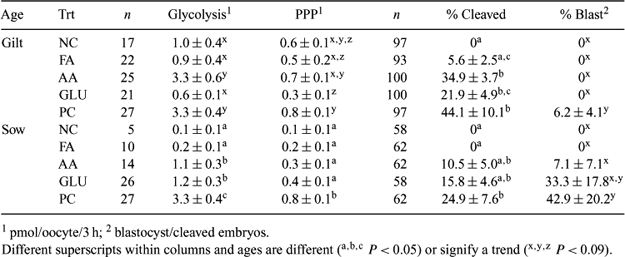301 EFFECT OF ENERGY SUBSTRATES ON METABOLISM, NUCLEAR MATURATION, AND DEVELOPMENT OF GILT AND SOW OOCYTES DURING IN VITRO MATURATION
L. Tubman A , A. Peter A and R. Krisher AADepartment of Animal Science, Purdue University, West Lafayette, IN 47907, USA. Email: rkrisher@purdue.edu
Reproduction, Fertility and Development 17(2) 301-301 https://doi.org/10.1071/RDv17n2Ab301
Submitted: 1 August 2004 Accepted: 1 October 2004 Published: 1 January 2005
Abstract
Metabolic mechanisms control both nuclear and cytoplasmic maturation in oocytes. Elevated glucose metabolism is typically associated with improved developmental competence. The objective of this study was to compare nuclear maturation, oocyte metabolism, and subsequent embryonic development following the use of different energy substrates during in vitro maturation (IVM) and to determine the specific role of each substrate. Cumulus-oocyte complexes (20–50/treatment (Trt)/replicate) were placed into maturation medium for 42 h in 7% CO2 in air at 38°C. Maturation treatments included a negative control (NC; 0.01 mM pyruvate and 6 mM lactate), addition of 1:100 dilution of fatty acids (FA; Gibco, Grand Island, NY, USA), 1 × NEAA/0.5 × EAA/1 mM glutamine (AA), or 2 mM glucose (GLU) individually; and a positive control (PC; addition of all three substrates). For each of six replicates, metabolism of 10 denuded oocytes/treatment was measured in hanging drops containing labeled glucose (0.0125 mM 5-3H glucose, glycolysis; 0.482 mM 1-14C glucose, pentose phosphate pathway, PPP). Oocytes were then fixed and stained for determination of meiotic stage. Remaining oocytes were fertilized and cultured in vitro. Cleavage and blastocyst development were recorded at 30–40 and 144 h post-insemination, respectively. The Purdue Porcine Media system was used throughout (PPM; Herrick et al. 2003 Reprod. Fertil. Dev. 15, 249–254). All data were subjected to analysis of variance. Oocyte metabolism and embryonic development are presented In Table 1. Except for FA, energy substrate influenced the percentage of oocytes reaching metaphase II (NC, 1.37 ± 0.01; FA, 1.35 ± 0.01; AA, 33.33 ± 0.06; GLU, 25.81 ± 0.06; PC, 54.29 ± 0.06) but age of oocyte donor did not. Blastocyst metabolism and cell number were not affected by treatment. In general, sows were more responsive to treatment effects. These data demonstrate that exogenous fatty acids do not play a role in porcine oocyte maturation. Amino acids appear to promote meiosis and glycolysis, but do not support oocyte developmental potential. Elevated metabolism in this treatment may be due to a recovery effect when glucose-starved oocytes were placed into glucose containing metabolism medium. Glucose appears to be important for meiosis and cytoplasmic maturation leading to developmental competence with minimal effect on oocyte metabolism. The success of the positive control suggests that a combination of glucose and amino acids is beneficial to maturation and embryonic development of porcine oocytes.

|


